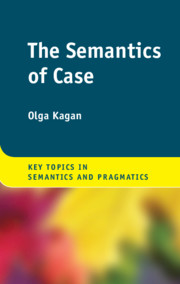Book contents
- The Semantics of Case
- Key Topics in Semantics and Pragmatics
- The Semantics of Case
- Copyright page
- Dedication
- Contents
- Figures
- Tables
- Acknowledgments
- Abbreviations
- 1 Introduction
- 2 Dative Case
- 3 Spatial Cases
- 4 Case and Aspect
- 5 Differential Object Marking
- 6 The Genitive/Accusative Alternation in Balto-Slavic
- 7 Predicate Case
- 8 Generalizations and Conclusions
- Terminology
- Bibliography
- Index
5 - Differential Object Marking
Published online by Cambridge University Press: 02 April 2020
- The Semantics of Case
- Key Topics in Semantics and Pragmatics
- The Semantics of Case
- Copyright page
- Dedication
- Contents
- Figures
- Tables
- Acknowledgments
- Abbreviations
- 1 Introduction
- 2 Dative Case
- 3 Spatial Cases
- 4 Case and Aspect
- 5 Differential Object Marking
- 6 The Genitive/Accusative Alternation in Balto-Slavic
- 7 Predicate Case
- 8 Generalizations and Conclusions
- Terminology
- Bibliography
- Index
Summary
Chapter 5 deals with (asymmetric) differential object marking (DOM), a phenomenon occurring in over 300 languages whereby the object of a verb can be either marked or unmarked for morphological case, depending on a number of factors. These factors have to do with the individuation/prominence of the object, often its definiteness, specificity and animacy value. The chapter begins with illustrations of the phenomenon in several languages, showing its sensitivity to different properties of the object. The reasoning behind DOM is then discussed. Two specific proposals are considered: one treats DOM as a signal of higher transitivity; the other views it as a disambiguation mechanism whereby a non-prototypical object is marked and, as a result, not confused with the subject. In addition to features of the object, properties of the verb have been argued to play a role in DOM; this relation is considered in a separate section. Further, several cross-linguistic analyses of the phenomenon are reviewed.
Keywords
- Type
- Chapter
- Information
- The Semantics of Case , pp. 147 - 188Publisher: Cambridge University PressPrint publication year: 2020
- 1
- Cited by



